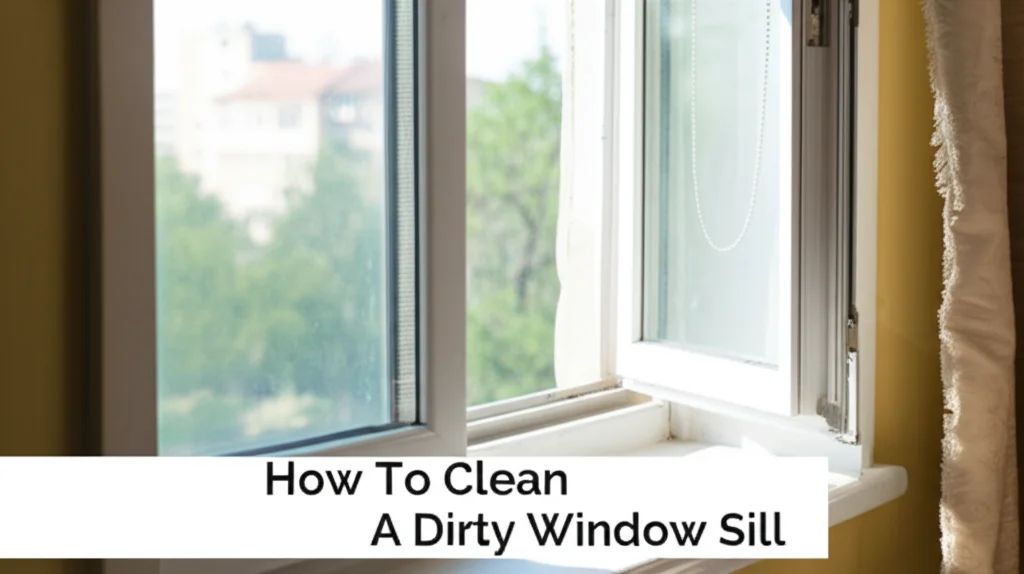· Home Cleaning · 6 min read
How To Clean A Dirty Window Sill

How To Clean A Dirty Window Sill
Have you noticed your windowsills are looking a little worse for wear? Dust, dirt, and grime can quickly accumulate, making your windows appear dull and your home feel less inviting. Cleaning a dirty window sill doesn’t have to be a daunting task. This guide will walk you through everything you need to know to restore your window sills to their former glory. We’ll cover everything from gathering supplies to tackling stubborn stains, ensuring your windows shine.
Cleaning your window sills regularly is important for maintaining the overall cleanliness and appearance of your home. It also helps prevent damage to the sill itself, especially if it’s made of wood. Let’s dive into the simple steps to get your window sills sparkling clean!
Quick Answer: To clean a dirty window sill, vacuum loose debris, then wash with warm, soapy water. For stubborn grime, use a paste of baking soda and water, or a vinegar solution. Rinse thoroughly and dry with a clean cloth.
Takeaway:
- Vacuum or brush away loose dirt.
- Use warm, soapy water for general cleaning.
- Tackle tough stains with baking soda or vinegar.
- Always rinse and dry thoroughly.
Why Are Window Sills So Dirty?
Window sills are magnets for dirt and grime. Think about it – they’re exposed to the elements, collecting dust, pollen, and even insect debris. Rain splatters dirt onto the sill, and everyday household activity contributes to the build-up. Understanding why they get dirty helps you address the problem effectively.
The material of your window sill also plays a role. Wood sills are prone to mildew and rot if not properly maintained. Vinyl and plastic sills can attract dust and become discolored over time. Regular cleaning prevents these issues and keeps your window sills looking their best. Don’t forget that window sills can also accumulate pet hair and tracked-in mud, especially in entryways.
Gathering Your Cleaning Supplies
Before you start, gather everything you’ll need. Having your supplies ready will make the cleaning process much smoother and more efficient. You likely already have most of these items in your home.
Here’s a checklist:
- Vacuum cleaner with brush attachment: For removing loose debris.
- Soft-bristled brush: An old toothbrush works great for corners.
- Warm water: The base for your cleaning solution.
- Dish soap: A mild detergent for general cleaning.
- Baking soda: A natural abrasive for stubborn stains.
- White vinegar: Excellent for cutting through grime and mildew.
- Spray bottle: For applying cleaning solutions.
- Clean cloths or microfiber towels: For washing and drying.
- Gloves (optional): To protect your hands.
Step-by-Step Guide to Cleaning Window Sills
Now that you have your supplies, let’s get cleaning! This step-by-step guide will help you tackle even the dirtiest window sills. Remember to work methodically for the best results.
- Remove Loose Debris: Start by vacuuming the window sill with the brush attachment. This will remove loose dirt, dust, and cobwebs. Pay attention to corners and crevices.
- Prepare Your Cleaning Solution: In a bowl or spray bottle, mix warm water with a few drops of dish soap. For tougher grime, you can create a paste of baking soda and water, or mix equal parts white vinegar and water.
- Apply the Cleaning Solution: Apply the cleaning solution to the window sill. If using a spray bottle, spray evenly. If using a paste, apply it directly to stained areas.
- Scrub Gently: Use a soft-bristled brush or cloth to scrub the window sill. For stubborn stains, let the cleaning solution sit for a few minutes before scrubbing. Avoid using abrasive cleaners or scrub brushes, as these can damage the surface.
- Rinse Thoroughly: Rinse the window sill with clean water to remove any remaining cleaning solution. You can use a damp cloth or a spray bottle filled with water.
- Dry Completely: Dry the window sill with a clean cloth or microfiber towel. This will prevent water spots and streaks.
Dealing with Stubborn Stains
Sometimes, a simple soapy water solution isn’t enough. Here’s how to tackle some common stubborn stains on window sills.
- Mold and Mildew: Mix equal parts white vinegar and water. Spray onto the affected area, let sit for 10-15 minutes, then scrub and rinse. If the mold is extensive, you may need a stronger mold remover. You can find more information on removing mold here.
- Hard Water Stains: Use undiluted white vinegar. Apply to the stains, let sit for a few minutes, then scrub and rinse.
- Sticky Residue: Try rubbing alcohol or a commercial adhesive remover. Test in an inconspicuous area first.
- Paint Splatters: Gently scrape off dried paint with a plastic scraper. Then, use a mild cleaning solution to remove any remaining residue.
Cleaning Different Types of Window Sills
The best cleaning method depends on the material of your window sill. Here’s a guide for different types:
- Wood Sills: Wood is porous and can be damaged by harsh chemicals. Use a mild soap and water solution, and avoid excessive moisture. Always dry thoroughly.
- Vinyl Sills: Vinyl is durable and easy to clean. You can use a variety of cleaning solutions, including vinegar and baking soda.
- Plastic Sills: Similar to vinyl, plastic sills are easy to clean. Avoid abrasive cleaners that can scratch the surface.
- Stone Sills: Stone sills require special care. Use a pH-neutral cleaner specifically designed for stone. Avoid acidic cleaners like vinegar.
Maintaining Clean Window Sills
Once you’ve cleaned your window sills, it’s important to maintain them. Regular maintenance will prevent dirt and grime from building up again.
- Dust Regularly: Dust your window sills weekly with a microfiber cloth.
- Wipe Up Spills Immediately: Clean up any spills or messes as soon as they happen.
- Inspect for Damage: Regularly inspect your window sills for cracks, chips, or signs of rot. Address any damage promptly to prevent further problems.
- Consider Protective Coatings: For wood sills, consider applying a protective coating like varnish or sealant to help prevent moisture damage. You might also want to look into how to keep your hardwood floors clean of dog hair here.
Frequently Asked Questions
Q: How often should I clean my window sills? A: Ideally, you should clean your window sills at least once a month. However, you may need to clean them more frequently if you live in a dusty area or have pets.
Q: Can I use bleach to clean my window sills? A: While bleach can be effective at killing mold and mildew, it can also damage some surfaces. It’s best to avoid using bleach unless absolutely necessary, and always dilute it properly.
Q: What’s the best way to clean old, painted window sills? A: Use a gentle cleaning solution and avoid scrubbing too hard, as this can damage the paint. Test the cleaning solution in an inconspicuous area first.
Q: How can I prevent mold from growing on my window sills? A: Ensure proper ventilation and keep the area dry. Regularly clean your window sills and address any water leaks promptly.
Conclusion
Cleaning a dirty window sill is a simple task that can make a big difference in the appearance of your home. By following these steps and maintaining a regular cleaning schedule, you can keep your window sills sparkling clean and prevent damage. Remember to choose the right cleaning solution for your window sill material and always rinse and dry thoroughly. A little effort goes a long way in keeping your home looking its best! Now that you know how to clean your window sills, why not tackle some other cleaning projects? Perhaps you’d like to learn how to clean your bathroom floor without a mop here.




